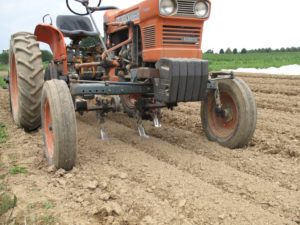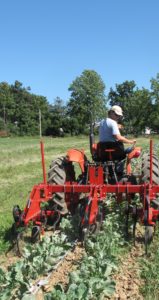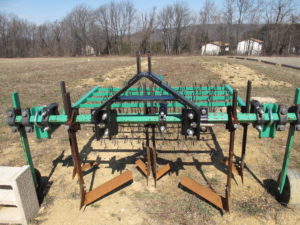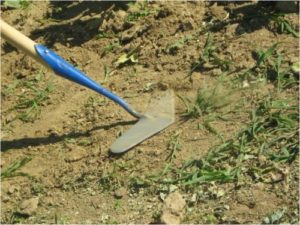Vegetable Equipment Considerations for New Farmers
by Sara Runkel and Tianna DuPont
Equipment is expensive. But often it can pay for itself quickly if you get the right tool for your farm. We would like to share a few considerations and tips we have learned through a recent equipment demonstration at the Seed Farm New Farmer Training and Incubator Program in Emmaus, PA as well as from our wonderful farmer neighbors and a few good resources. We hope descriptions of different options will help you find the right equipment for your farm.
Hoes have been around since pre-dynastic Egypt, and there are many types out there. The stirrup hoe is a standard on small vegetable farms. The oscillating blade slices right under the soil surface, cutting off small weeds on both the pull and push. Available in many widths, it works well in most soil conditions. Like all hoes it works best on small weeds, but it can be used on larger weeds too. The collinear hoe works only on the pull. The thin blade works best on small weeds. It can slide into tight places between plants and you can slip it right under drip tape. The European push hoe (Photo 1) is a favorite of some of our apprentices. It has a really long handle with a pistol grip which makes it easier for the operator to stand up straight and have a comfortable grip. The whale tale shaped blade rides just under the soil surface cutting off small weeds. With a wider blade then most, it works well on widely spaced crops, but more challenging to use for in-row weeds. The swan neck hoe from Dewitt also has a long handle which helps even tall folks stand upright while they hoe. It is used with a sweeping motion that can be hard for Americans to get used to.

Photo 2. Belly mounted sweeps allow for precision cultivation. This tractor also has an offset which allows the operator to look down on the crop he/she is cultivating.
Photo by: Tianna DuPont
No matter which hoe you use, it is important to think about ergonomics. The blade should be parallel to the ground. You don’t want to be hunched over. And make sure you sharpen your hoe! It can really cut down on productivity and be hard on your body to deal with a dull hoe. When explaining how to sharpen tools I like to use steps I borrowed from Josh Volk, Slow Hand Farms: For a hoe you want a 30 degree bevel. A six inch single mill bastard file with a handle works well. Files cut only on the forward stroke. Try not to drag them backwards which will dull the file. Slide the file smoothly across the blade using even pressure all the way across. For many hoes like a stirrup where there is an angle on only one side of the blade, use one or two quick strokes to take off the bur on the back. The bevel should be flat, not rounded.
There are many types of cultivators out there. Many of our neighbor farmer colleagues prefer belly mounted cultivators with sets of sweeps or knives (Photo 2). The great thing about a belly mount is you are looking down on the crop and so you can get very close and run a lower risk of looking back which causes the inevitable swerve to the side. Specialized cultivating tractors with offset seats and engines improve the operator’s view of the crop.

Photo 3. Seed Farm manager, Sara Runkel demonstrates a low residue cultivator with S tines and sweeps set up for two rows at a recent field day.
Photo by: Tianna DuPont
We are currently using two cultivators at the farm: a Low Residue Cultivator (from I&J) and the Williams Tools System with side knives and tines. The Low Residue Cultivator has a set of S shanks with duck sweeps (Photo 3). The S shanks have a little flex so they vibrate vigorously, shattering soil, knocking soil from weed roots and leaving weeds exposed on the soil surface [1]. Instead of one larger sweep between rows there are multiple sweeps attached to a parallel linkage on the main tool bar which helps get all the weeds. However, they call it a low residue cultivator because all those sweeps also do a good job of catching field trash and wrapping it around the sweeps. This cultivator, like many others, works better on a flat bed system. It is very useful to have a set of gauge wheels to keep sweeps at a consistent height. Since the sweeps are just going an inch below the surface you don’t need a lot of horse power to use it. Our Kubota only has 23 horsepower and it works fine.
We also trialed a multi-component weeding frame called the Williams Tools System (Photo 4). The Williams is a tool bar with multiple sets of spring (or flex) tines as well as an additional tool bar where you can mount side knives or other cultivators (we use side knives). The flex tine weeder can be used to blind cultivate or by lifting up tines over the row to work around crops up to 16” tall. The tines rake the soil surface to pull out and expose sprouting and emerging weeds. Many farmers use tine weeders pre-emergence for large seeded crops. For example, at Summit Valley Farm in New Holland PA, Wade Espenshade uses a Kovar flex tine four or five days after planting corn. The crop is not up yet and corn planted 1 ½ inch deep is not bothered by the surface disturbance. The trick with tine weeding is it works best on tiny weeds before they emerge. If you can see the weeds it may already be too late. Three great things about a flex tine weeder are: (1) it kills in-row weeds, (2) it’s fast (Wade runs it at 8-10 mph) and (3) it helps conserve moisture and suppress new weeds by creating a dust mulch in the top ¼ inch. This thin dried layer holds moisture below and makes it hard for the weeds to germinate.
Vegetable farmers we know also use flex tines pre-emergence on carrots and other slow to emerge crops. The carrot seed which has not germinated yet just moves around under the soil. After the crop is up you have to go much slower but you can tine weed many direct seeded vegetable crops, killing in-row as well as between row weeds. Don’t use it right away though on transplanted crops and you have to get to know which direct seeded crops can take the thrashing. For example, Bill Chambers in Oregon says he does not disturb pumpkins for ten days after germination [1]. Disadvantages of flex times include (1) Cultivation timing is critical weeds with four or more leaves and (2) emerged grasses at any stage are rarely controlled. Therefore, early-season flex-tine harrowing should be integrated with a more aggressive cultivator. Research in transplanted broccoli, snap beans, and sweet corn has shown that flex-tine harrows can reduce crop stand and yield when used before the crop is well rooted [2].

Photo 4. Toolbar with both side knives and spring tines. The large knives on the front are pumpkin knives that can reach in under spreading crops.
Photo by: Tianna DuPont
Once the plants (or the weeds) get a little bigger we use side knives on the same tool bar to cut off weeds and throw some soil into the row to cover other weeds. Side knives do not generally throw as much soil as sweeps. You can reverse them to throw more or less soil.
When you are buying a tool bar mounted cultivator, make sure it is sized for your tractor. You want to make sure you are covering your tire tracks. You will also want to make sure that the duck sweeps used to cultivate behind your tires are wide enough. They should be matched to your wheel width.
If you are mid-scale and plan to seed or transplant by hand, another useful tool might be a row marker. With an idea borrowed from Quiet Creek Farm in Kutztown, we mounted a set of three row marking knives on a tool bar. This allows us to mark three (or two) parallel furrows down the bed. Then, even when hand seeding or transplanting we can still come back and cultivate with the tractor without knocking out plants (see marked rows in Photo 3).
For more information about the Seed Farm equipment demonstration visit www.theseedfarm.org. The Seed Farm links new farmers with training, equipment and land through its Apprenticeship and Farm Incubator Programs eliminating the top three barriers to farm entry, and opening doors for a new generation of farmers. The training program is currently accepting applications due October 15, 2012.
References and Resources:
[1] Bowman, G., ed. Steel in the Field: A Farmers Guide to Weed Management Tools. 1997, Sustainable Agriculture Network: Beltsville, Maryland.
[2] Grubinger, V. Cultivation Equipment for Weed Control: Pros, Cons and Sources. Vermont Cooperative Extension, 2001.



Hi! Thanks or a helpful article.
I am trying to find out more about flex tine harrowing like with the Williams Tool on transplant crops but can’t find a lot of info on best practices. Can you share anything else? I found the Vermont article but couldn’t find something to substantiate the “research in transplanted broccoli, snap beans, and sweet corn has shown that flex-tine harrows can reduce crop stand and yield when used before the crop is well rooted [2].”
I am sure this is a trial by error type thing but it seems the tines would be great for not covering the crop and allowing in-row weeding after a certain point. Wanting to get a handle on when this can be done on other types of transplants.
Thanks!
Thank you Sarah!
Hello,
I am new to the farm equipment portion of my vegetable production. I started last year with one acre doing things by hand, and kept up so I increased my land to five acres with a full time job. The weeds are killing me and my produce…. Could you recommend something for me to use to help keep the weeding to a minimum. I grow many varieties, everything from artichokes to zucchini, vines included. Currently, I need to rototill every weekend at one plot because, bless my dad’s heart, he gave me really great ground. However, the weeds grow really well there, too. The other site I use, is abused farm land that needs some work, so the weeds don’t return so quickly there. I need something to weed under the vines, which I didn’t even know was possible until I read this article, and something to go in between rows.
where can I find a flex tine weeder setup for a small cat 1 tractor?
Hi Moses,
I would recommend reaching out to one of the authors of the article :
Sara Runkel is the Seed Farm Executive Director. She can be reached at sara_runkel@theseedfarm.org. Tianna DuPont is a sustainable agriculture educator with Penn State Extension. She can be reached at tdupont@psu.edu or (610) 746-1970.
Perhaps Sara and/or Tianna can offer advice on finding a flex tine weeder setup.
Best,
Kelsie
Hi Kelsie,
It’s strange, but none of those emails addresses work
Hi Moses,
If the links don’t work, did you try to manually type in the email addresses? If this still doesn’t work, I would recommend reaching out to your local Cornell Cooperative Extension office/contact which can be found through this interactive map: https://smallfarms.cornell.edu/contact/local-contacts/. Please let me know if you still have trouble!
Put Slope Game on Top gg guys!